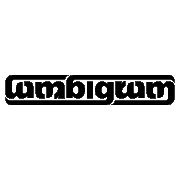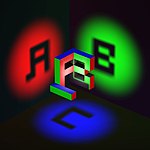Ambigram: Difference between revisions
date-tagged citation template |
No edit summary |
||
| Line 1: | Line 1: | ||
[[Image:ambigram rotating.gif|thumb|right|200px|An animation of a rotationally symmetric ambigram for the word "ambigram"]] |
[[Image:ambigram rotating.gif|thumb|right|200px|An animation of a rotationally symmetric ambigram for the word "ambigram"]] |
||
An '''ambigram''', also sometimes known as an '''inversion''' or '''flipscript''', is a graphical figure that spells out a word not only in its form as presented, but also in another direction or orientation. The text can also consist of a few words, and the text spelled out in the other direction or orientation is often the same, but can also be a different text. [[Douglas R. Hofstadter]] describes an ambigram as a "calligraphic design that manages to squeeze two different readings into the selfsame set of curves." |
An '''ambigram''', also sometimes known as an '''inversion''' or '''flipscript''', is a graphical figure that spells out a word not only in its form as presented, but also in another direction or orientation. The text can also consist of a few words, and the text spelled out in the other direction or orientation is often the same, but can also be a different text. [[Douglas R. Hofstadter]] describes an ambigram as a "calligraphic design that manages to squeeze two different readings into the selfsame set of curves." The term "ambigram" was first used to mean "ambiguous anagram" by Judith E. Bagai, editor of The Enigma, the official organ of The National Puzzlers' League. |
||
According to practitioner [[John Langdon (typographer)|John Langdon]], ambigrams were independently invented by himself and by [[Scott Kim]] in the 1970s.<ref name="Doodle">{{cite news |
According to practitioner [[John Langdon (typographer)|John Langdon]], ambigrams were independently invented by himself and by [[Scott Kim]] in the 1970s.<ref name="Doodle">{{cite news |
||
Revision as of 03:20, 30 September 2008

An ambigram, also sometimes known as an inversion or flipscript, is a graphical figure that spells out a word not only in its form as presented, but also in another direction or orientation. The text can also consist of a few words, and the text spelled out in the other direction or orientation is often the same, but can also be a different text. Douglas R. Hofstadter describes an ambigram as a "calligraphic design that manages to squeeze two different readings into the selfsame set of curves." The term "ambigram" was first used to mean "ambiguous anagram" by Judith E. Bagai, editor of The Enigma, the official organ of The National Puzzlers' League.
According to practitioner John Langdon, ambigrams were independently invented by himself and by Scott Kim in the 1970s.[1] Kim used the name Inversions as the title of his first collection in 1981. The first published reference to "ambigram" was by Hofstadter, who attributes the origin of the word to conversations among a small group of friends during 1983–1984.[1] The 1999 edition of Hofstadter's Gödel, Escher, Bach features a 3-D ambigram on the cover.
Ambigrams became much more popular as a result of Dan Brown incorporating them into the plot of his bestseller, Angels & Demons; Langdon produced ambigrams that were used for the book cover, and a link to his website from Brown's meant he was "suddenly inundated" with commissions.[1]. In fact the name Robert Langdon (the hero from the novel) is also an appreciation to Mr. John Langdon.[citation needed]
Ambigram types



Ambigrams usually fall into one of several categories:
- Rotational
- A design that presents several instances of words when rotated through a fixed angle. This is usually 180 degrees, but rotational ambigrams of other angles exist, for example 90 or 45 degrees. The word spelled out from the alternative direction(s) is often the same, but may be a different word to the initially presented form. A simple example is the lower-case abbreviation for "Down", dn, which looks like the lower-case word up when rotated 180 degrees.
- Mirror
- A design that can be read when reflected in a mirror, usually as the same word or phrase both ways. Ambigrams that form different words when viewed in the mirror are also known as glass door ambigrams, because they can be printed on a glass door to be read differently when entering or exiting.
- Figure-ground
- A design in which the spaces between the letters of one word form another word.
- Chain
- A design where a word (or sometimes words) are interlinked, forming a repeating chain. Letters are usually overlapped meaning that a word will start partway through another word. Sometimes chain ambigrams are presented in the form of a circle.
- Space-filling
- Similar to chain ambigrams, but tile to fill the 2-dimensional plane.
- Fractal
- A version of space-filling ambigrams where the tiled word branches from itself and then shrinks in a self-similar manner, forming a fractal. See Scott Kim's fractal of the word TREE for an animated example.
- 3-dimensional
- A design where an object is presented that will appear to read several letters or words when viewed from different angles. Such designs can be generated using constructive solid geometry.
- Perceptual shift
- A design with no symmetry but can be read as two different words depending on how the curves of the letters are interpreted.
- Natural
- A natural ambigram is a word that possesses one or more of the above symmetries when written in its natural state, requiring no typographic styling. For example, the words "dollop" and "suns" are natural rotational ambigrams. The word "bud" forms a natural mirror ambigram when reflected over a vertical axis. The words "CHOICE" and "OXIDE", in all capitals, form a natural mirror ambigram when reflected over a horizontal axis. The word "TOOTH", in all capitals, forms a natural mirror ambigram when its letters are stacked vertically and reflected over a vertical axis.
- Symbiotogram
- An Ambigram that, when rotated 180 degrees, can be read as a different word to the original.
Ambigrams are exercises in graphic design that play with optical illusions, symmetry and visual perception. Ambigram lovers value especially those with a relation between form and content.
Examples

Graphic artists use ambigrams because of their unique symmetry. Ambigrams thus appear in commercial logos, covers of books and music albums, and tattoo designs.
Ambigrams feature prominently in Dan Brown's novel, Angels and Demons, of which the first UK release featured an ambigram of the title on the cover. The ambigrams in the novel were designed by graphic artist John Langdon. Since the release of the bestseller sequel The Da Vinci Code, there has been a marked increase in the popularity and awareness of ambigrams, leading to a reprint of John Langdon's book on ambigrams entitled Wordplay.
Another example appears in the short story Emma Zunz by Jorge Luis Borges. In this case, the surname of the eponymous main character can be read the same way right side up and upside down.
The comicbook New X-Men used ambigram logo, featuring the name of the title.
The following ambigram examples all have rotational symmetry, unless otherwise noted.
Books
- Abarat, on the cover of the book by Clive Barker
- Angels and Demons, on the cover of the first edition of Angels and Demons by Dan Brown, as well as the Illuminati brands in the text
- Justin Thyme, on the cover of Justin Thyme by Panama Oxridge
- Wordplay, on the cover of John Langdon's book on ambigrams. The author's name also appears on the cover as an ambigram.
Music
 , the logo for the band ABBA
, the logo for the band ABBA , the logo for the band Nine Inch Nails
, the logo for the band Nine Inch Nails- "ANGEL"logo[2], on the cover of a 1977 recording from Casablanca Records, designed by Robert Petrick
- CiRCADiAN, the logo and album cover of 5th PROJEKT's CiRCADiAN
- Paul McCartney, on an alternate cover for his album Chaos and Creation in the Backyard
Other logos
- DMC, the logo for the De Lorean Motor Company.
- BLACKSMITH, the logo on the website for Warner Music Group's sub label Blacksmith Records
- GOES, the logo for NASA's Geostationary Operational Environmental Satellite satellite, designed by Scott Kim
- Mosuki, the logo for the online calendar sharing site
- Newman, the logo for the French clothes manufacturer, designed in 1969 by Raymond Loewy
- New X-Men, the logo for the comic book series
- РИa, the logo for Novosti, the Russian News and Information Agency
- The title on the cover of the 20th Anniversary DVD release of The Princess Bride
- The 4S sun (rotationally symmetric chain ambigram), the logo for Sun Microsystems, designed by Vaughan Pratt
- The "Trick/Treat" cards used in Derren Brown's "Trick or Treat" TV series.
- The Honda Civic logo.
See also
Template:Illustrated Wikipedia
References
- Kim, Scott, Inversions, Byte Books (1981)
- Hofstadter, Douglas R., "Metafont, Metamathematics, and Metaphysics: Comments on Donald Knuth's Article 'The Concept of a Meta-Font'" Scientific American (August 1982) (republished in the book Metamagical Themas)
- Langdon, John, Wordplay: Ambigrams and Reflections on the Art of Ambigrams, Harcourt Brace (1992, republished 2005)
- Hofstadter, Douglas R., Ambigrammi, Hopefulmonster Editore Firenze (1987) (in Italian)
- Polster, Burkard, Les Ambigrammes l'art de symétriser les mots, Editions Ecritextes (2003) (in French)
- Polster, Burkard, Eye Twisters: Ambigrams, Escher, and Illusions, web-based book available at http://www.maths.monash.edu.au/~bpolster/ambigram.html (date unknown)
- ^ a b "The doodle bug". The Telegraph. April 11 2005. Retrieved 2007-09-30.
{{cite news}}: Check date values in:|date=(help)
External links
- Ambigrams, Logos, Word Art by graphic artist John Langdon
- Advice on Ambigrams, John Langdon's tutorial for beginning ambigrammists
- Inversions by Scott Kim
- Ambigram.Matic automatic Ambigram generator
- Ambigramania online community for Ambigram enthusiasts
- Ambigrams at Curlie
